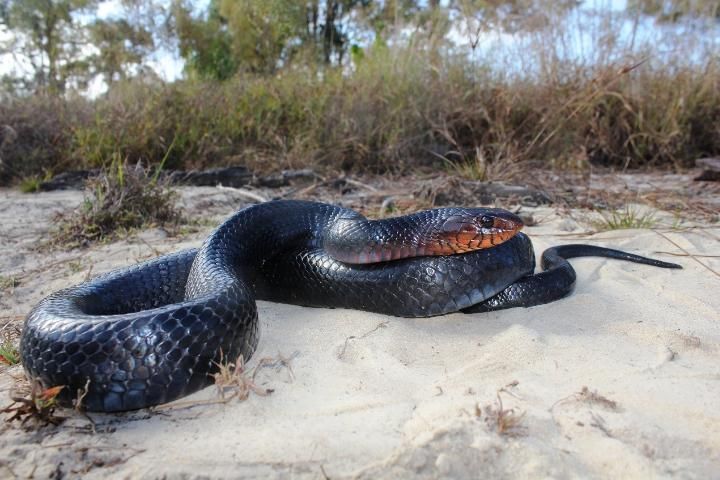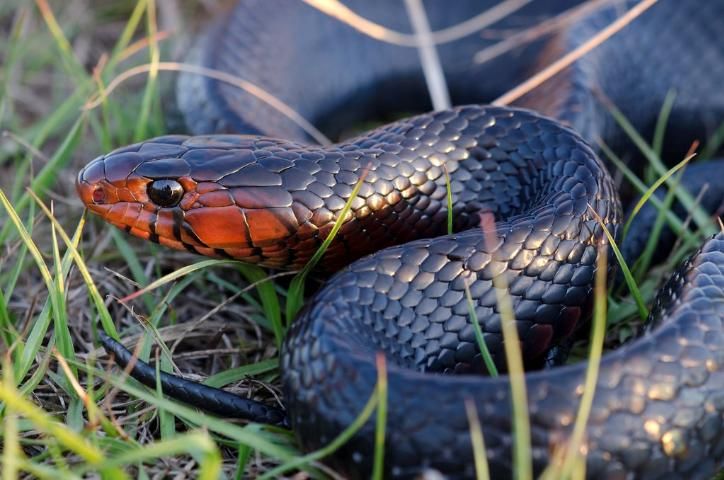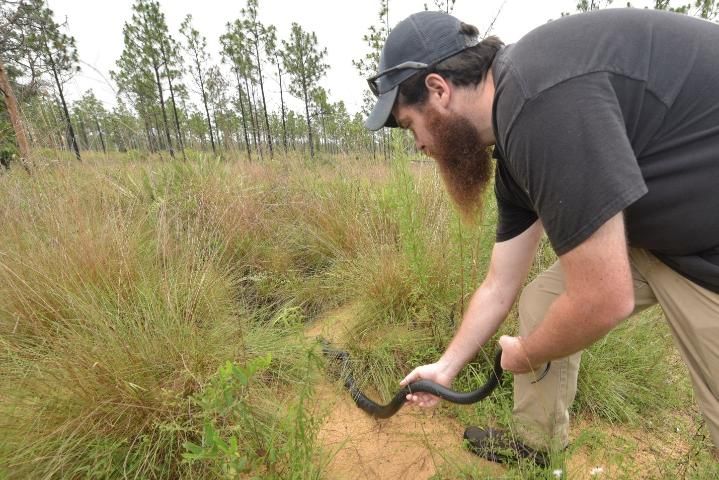Breeding: winter, spring
Habitat: flatwoods, scrub, oak hammocks, wetlands, grasslands
Status: threatened
Scientific Name: Drymarchon couperi
Common name: Eastern indigo snake, blue indigo snake, gopher snake, blue bull snake.
Habitat: Longleaf pine forest, xeric pinelands, tropical hardwood hammocks, upland scrubs, wet prairies.
Physical Description: Nonvenomous, large-bodied, glossy, iridescent bluish-black snake with smooth scales. The sides of the head and chin are typically reddish orange but can be white or black. Males are larger and longer than females and males have a slightly keeled scale on the middle three dorsal scale rows, whereas females do not. Juveniles are similar to adults but with more red on their heads. Hatchlings can also have white speckling across the body.
Length: Up to 8 ft, average of 5–6.5 ft.
Reproductive Rate: Lay 4–12 eggs a year between April and June; eggs hatch after approximately 90 days.
Lifespan: Unknown in the wild, but up to 25 years in captivity.
Dispersal & Home Range: Largest known home range of any snake species in North America, ranging from 53 acres for females in central Florida to 1260 acres for males in Georgia (see Biology and Behavior). Little is known about dispersal, but one record shows a young adult male moving 13.6 miles between two overwintering sites.

Credit: GTM NERR, Kevin Enge, (CC BY-NC)
Biology and Behavior
Eastern indigo snakes are relatively large and near the top of the food chain. They hunt during the day, and other snakes (both venomous and nonvenomous) are their main diet. However, they will also eat frogs, birds, small mammals, and any other animal they can overpower. The eastern indigo snake requires a mosaic of various habitats to carry out their life cycle. In South-central Florida, they have been observed in xeric pinelands, tropical hardwood hammocks, citrus groves, upland scrubs, and wet prairies. In northern Florida, they primarily occupy longleaf pine forests, which contain burrows created by gopher tortoises. During the winter months, they seek burrows for thermal refugia and become relatively inactive due to the colder temperatures. However, in south-central Florida, they remain active on the surface all year. In the heat of the summer, they retreat to nearby wetlands. These variations in habitat and location may influence population density, mating opportunities, prey abundance, and, in turn, movements and home range size. In Georgia, average home range size is 250 and 1,260 acres; in north-central Florida, average home range size is 53 and 392 acres; and in south-central Florida, average home range size is 117 and 341 acres, for females and males, respectively for each location. Eastern indigo snakes are a late-maturing snake, with males reaching sexual maturity at 2–3 years and females 3–4 years, at a length of 5 to 6 feet. Breeding occurs from October through March with a peak during November through January. Females lay their eggs in April through June. Little is known about nest sites, but gopher tortoise burrows are suspected to be a common nesting location. In addition to gopher tortoise burrows, Eastern indigo snakes will also use mammal burrows, underground root systems, and hollowed out logs as refugia and possible nest sites.
History
The eastern indigo snake was once widely distributed throughout Florida and the coastal plain of Mississippi, Alabama, and Georgia. They were listed as federally threatened when populations began to decline due to the illegal pet trade, reduction in the extent and quality of longleaf pine forests, and gassing of gopher tortoise burrows in search of rattlesnakes. Populations have continued to slowly decline despite their listing status due to further loss of longleaf pine forests combined with increasing urbanization and habitat fragmentation.
Timeline
1800—Longleaf pine forests cover >90% of the southeastern coastal plain.
1842—Eastern indigo snake is originally described.
1978—Eastern indigo snake is listed as federally threatened.
1982—Few populations, if any, remain in the Florida Panhandle.
1990—Longleaf pine forests cover less than 3% of the southeastern coastal plain.
2008—Reintroduction of Eastern indigo snake begins in Alabama.
2012—Increasing habitat fragmentation in peninsular Florida leads to decreased survival.
2017—Reintroduction efforts begin in the Florida panhandle.
Did you know?
Eastern indigo snakes are the longest native snake in North America!
Fast Facts
- Eastern indigo snakes are federally protected under the Endangered Species Act. Do not touch, hold, or harass indigo snakes.
- They do not constrict like most snakes but overpower prey with their powerful bite.
- The scientific genus Drymarchon means "forest ruler."

Credit: U.S. Forest Service Southern Region, Public domain
Distribution
The eastern indigo snake is now found only in the coastal plain of Georgia, Florida, and, due to successful reintroduction efforts, Alabama. In Georgia and Alabama, they are restricted to the coastal plain region (see map) within xeric (dry) sandhills and longleaf pine forests interspersed with gopher tortoise burrows. Indigo snakes use burrows throughout their range but especially in the northern part, where burrows provide critical overwintering habitat and protection from the cold stress thought to impact the snakes' survival. Although they are found throughout Florida, their abundance varies regionally. Today, they are likely extirpated or very rare in Florida’s Panhandle. Though a reintroduction project is underway in the Panhandle, it is too early to determine whether it will result in a stable population. South-central Florida still has relatively stable isolated populations of eastern indigo snakes, which is thought to be due to less development and warmer temperatures. In south-central Florida, eastern indigo snakes are most common along sandy ridges and in xeric sandhills and flatwoods but they will venture into adjacent habitats. Though stable populations remain in south-central Florida, studies have indicated a decrease in survival within fragmented landscapes, which emphasizes the need to conserve expansive tracts of land. Eastern indigo snakes can still be found on some barrier islands of Florida within sand dune and scrub habitats. Due to drier habitat preferences, eastern indigo snakes are relatively uncommon in the wetter habitats of the seasonally flooded Everglades and are more associated with pine rockland habitat. They have also been found in a few sites along the Florida Keys.

Credit: UF/IFAS, adapted from Javan Bauder from the Species Status Assessment Report for the Eastern Indigo Snake Version 1, November 5, 2018, U.S. Fish and Wildlife Service. https://ecos.fws.gov/ServCat/DownloadFile/157073
The Threatened Forest
The longleaf pine-wiregrass ecosystem, a preferred habitat of eastern indigo snakes, once covered the coastal plain of the southeastern United States. The frequent lightning strikes in May–July resulted in frequent low-intensity fires that were crucial in maintaining the ecosystem. This ecosystem is considered to be as biologically diverse as a rainforest, with records of up to 40 species of plants per 10 ft2. Historically, this system stretched from Texas to Virginia, but today less than 3% percent remains. The decline of the longleaf ecosystem is largely due to fire suppression and conversion of forest to agricultural lands and slash pine plantations. Historically, the naval store industry extracted oleoresin from longleaf pines to create turpentine, tar, and pitch. These products were used to waterproof the hulls of wooden ships and generate lamp oil, medicine, and paint. The longleaf ecosystem has been severely degraded, and, as a result, many species that depend upon it are endangered or threatened, including the eastern indigo snake, red-cockaded woodpecker, gopher tortoise, gopher frog, and the flatwoods salamander.

Credit: Florida Fish and Wildlife Conservation Commission, Tom Donovan (CC BY-NC-ND)
How You Can Help
- Educate others on the threatened status of the eastern indigo snake.
- Don't harass or kill eastern indigo snakes.
- Support eastern indigo snake conservation by supporting federal, state, and private agencies.
More information and factsheets at https://edis.ifas.ufl.edu